Case Study Reflective Essay on Unprofessional Conduct in Practice
VerifiedAdded on 2022/08/17
|7
|1510
|18
Essay
AI Summary
This essay analyzes a case study of unprofessional conduct in nursing, identifying five key acts: patient safety violations, compromised quality of care, documentation deficiencies, lack of clinical skills, and failure to provide patient-centered care. The essay outlines the implications of these acts, including potential harm to patients and breaches of professional standards. It discusses the consequences of these actions, emphasizing the importance of patient safety laws, quality care plans, and accurate documentation. The author reflects on the nurse's actions, highlighting the nurse's lack of knowledge, inattentiveness, and failure to adhere to professional responsibilities, which ultimately deteriorates the healthcare environment. The essay also explores the role of clerks in addressing these issues, emphasizing the impact of unprofessional conduct on patient care, treatment plans, and hospital administration.
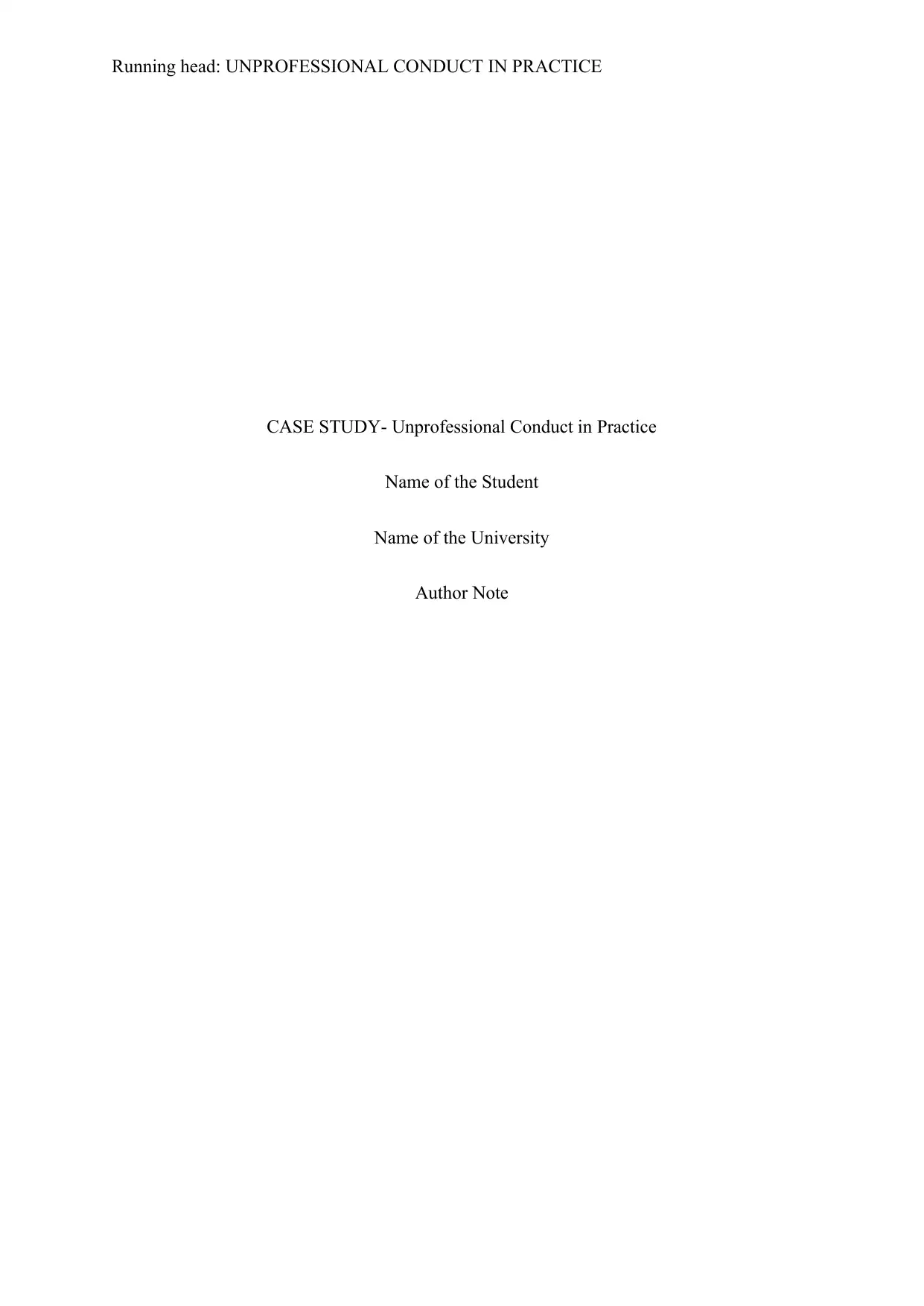
Running head: UNPROFESSIONAL CONDUCT IN PRACTICE
CASE STUDY- Unprofessional Conduct in Practice
Name of the Student
Name of the University
Author Note
CASE STUDY- Unprofessional Conduct in Practice
Name of the Student
Name of the University
Author Note
Paraphrase This Document
Need a fresh take? Get an instant paraphrase of this document with our AI Paraphraser
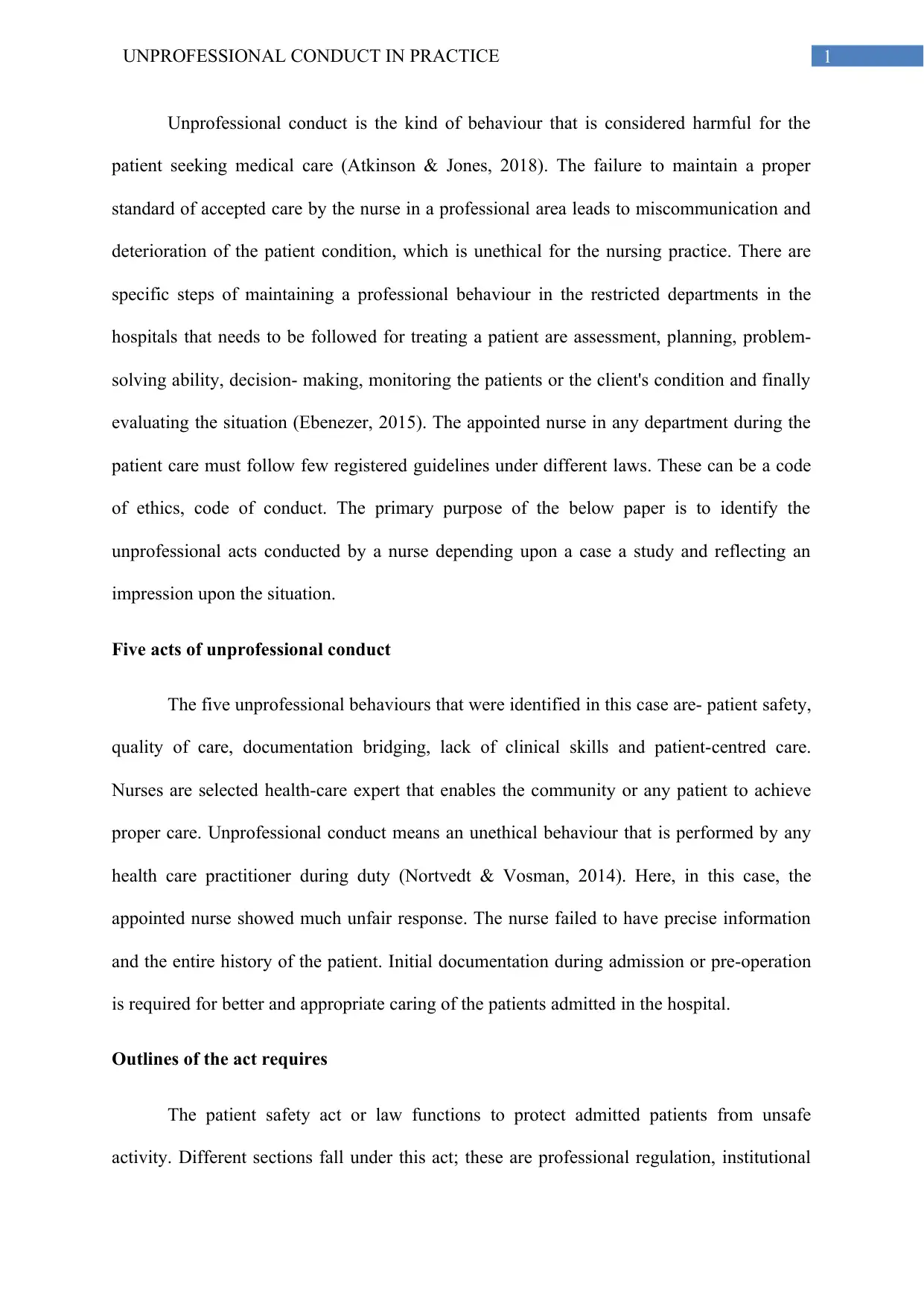
1UNPROFESSIONAL CONDUCT IN PRACTICE
Unprofessional conduct is the kind of behaviour that is considered harmful for the
patient seeking medical care (Atkinson & Jones, 2018). The failure to maintain a proper
standard of accepted care by the nurse in a professional area leads to miscommunication and
deterioration of the patient condition, which is unethical for the nursing practice. There are
specific steps of maintaining a professional behaviour in the restricted departments in the
hospitals that needs to be followed for treating a patient are assessment, planning, problem-
solving ability, decision- making, monitoring the patients or the client's condition and finally
evaluating the situation (Ebenezer, 2015). The appointed nurse in any department during the
patient care must follow few registered guidelines under different laws. These can be a code
of ethics, code of conduct. The primary purpose of the below paper is to identify the
unprofessional acts conducted by a nurse depending upon a case a study and reflecting an
impression upon the situation.
Five acts of unprofessional conduct
The five unprofessional behaviours that were identified in this case are- patient safety,
quality of care, documentation bridging, lack of clinical skills and patient-centred care.
Nurses are selected health-care expert that enables the community or any patient to achieve
proper care. Unprofessional conduct means an unethical behaviour that is performed by any
health care practitioner during duty (Nortvedt & Vosman, 2014). Here, in this case, the
appointed nurse showed much unfair response. The nurse failed to have precise information
and the entire history of the patient. Initial documentation during admission or pre-operation
is required for better and appropriate caring of the patients admitted in the hospital.
Outlines of the act requires
The patient safety act or law functions to protect admitted patients from unsafe
activity. Different sections fall under this act; these are professional regulation, institutional
Unprofessional conduct is the kind of behaviour that is considered harmful for the
patient seeking medical care (Atkinson & Jones, 2018). The failure to maintain a proper
standard of accepted care by the nurse in a professional area leads to miscommunication and
deterioration of the patient condition, which is unethical for the nursing practice. There are
specific steps of maintaining a professional behaviour in the restricted departments in the
hospitals that needs to be followed for treating a patient are assessment, planning, problem-
solving ability, decision- making, monitoring the patients or the client's condition and finally
evaluating the situation (Ebenezer, 2015). The appointed nurse in any department during the
patient care must follow few registered guidelines under different laws. These can be a code
of ethics, code of conduct. The primary purpose of the below paper is to identify the
unprofessional acts conducted by a nurse depending upon a case a study and reflecting an
impression upon the situation.
Five acts of unprofessional conduct
The five unprofessional behaviours that were identified in this case are- patient safety,
quality of care, documentation bridging, lack of clinical skills and patient-centred care.
Nurses are selected health-care expert that enables the community or any patient to achieve
proper care. Unprofessional conduct means an unethical behaviour that is performed by any
health care practitioner during duty (Nortvedt & Vosman, 2014). Here, in this case, the
appointed nurse showed much unfair response. The nurse failed to have precise information
and the entire history of the patient. Initial documentation during admission or pre-operation
is required for better and appropriate caring of the patients admitted in the hospital.
Outlines of the act requires
The patient safety act or law functions to protect admitted patients from unsafe
activity. Different sections fall under this act; these are professional regulation, institutional
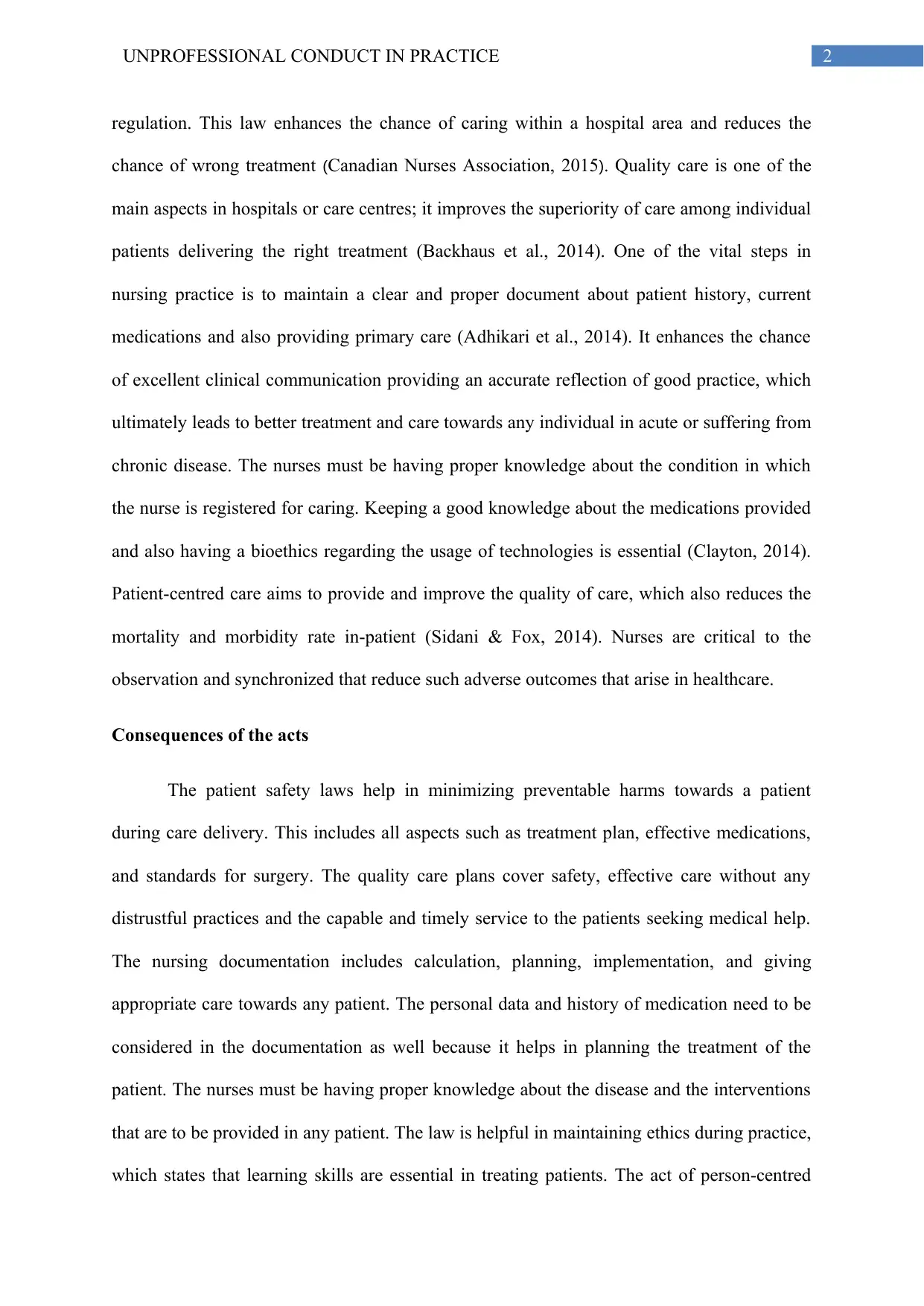
2UNPROFESSIONAL CONDUCT IN PRACTICE
regulation. This law enhances the chance of caring within a hospital area and reduces the
chance of wrong treatment (Canadian Nurses Association, 2015). Quality care is one of the
main aspects in hospitals or care centres; it improves the superiority of care among individual
patients delivering the right treatment (Backhaus et al., 2014). One of the vital steps in
nursing practice is to maintain a clear and proper document about patient history, current
medications and also providing primary care (Adhikari et al., 2014). It enhances the chance
of excellent clinical communication providing an accurate reflection of good practice, which
ultimately leads to better treatment and care towards any individual in acute or suffering from
chronic disease. The nurses must be having proper knowledge about the condition in which
the nurse is registered for caring. Keeping a good knowledge about the medications provided
and also having a bioethics regarding the usage of technologies is essential (Clayton, 2014).
Patient-centred care aims to provide and improve the quality of care, which also reduces the
mortality and morbidity rate in-patient (Sidani & Fox, 2014). Nurses are critical to the
observation and synchronized that reduce such adverse outcomes that arise in healthcare.
Consequences of the acts
The patient safety laws help in minimizing preventable harms towards a patient
during care delivery. This includes all aspects such as treatment plan, effective medications,
and standards for surgery. The quality care plans cover safety, effective care without any
distrustful practices and the capable and timely service to the patients seeking medical help.
The nursing documentation includes calculation, planning, implementation, and giving
appropriate care towards any patient. The personal data and history of medication need to be
considered in the documentation as well because it helps in planning the treatment of the
patient. The nurses must be having proper knowledge about the disease and the interventions
that are to be provided in any patient. The law is helpful in maintaining ethics during practice,
which states that learning skills are essential in treating patients. The act of person-centred
regulation. This law enhances the chance of caring within a hospital area and reduces the
chance of wrong treatment (Canadian Nurses Association, 2015). Quality care is one of the
main aspects in hospitals or care centres; it improves the superiority of care among individual
patients delivering the right treatment (Backhaus et al., 2014). One of the vital steps in
nursing practice is to maintain a clear and proper document about patient history, current
medications and also providing primary care (Adhikari et al., 2014). It enhances the chance
of excellent clinical communication providing an accurate reflection of good practice, which
ultimately leads to better treatment and care towards any individual in acute or suffering from
chronic disease. The nurses must be having proper knowledge about the condition in which
the nurse is registered for caring. Keeping a good knowledge about the medications provided
and also having a bioethics regarding the usage of technologies is essential (Clayton, 2014).
Patient-centred care aims to provide and improve the quality of care, which also reduces the
mortality and morbidity rate in-patient (Sidani & Fox, 2014). Nurses are critical to the
observation and synchronized that reduce such adverse outcomes that arise in healthcare.
Consequences of the acts
The patient safety laws help in minimizing preventable harms towards a patient
during care delivery. This includes all aspects such as treatment plan, effective medications,
and standards for surgery. The quality care plans cover safety, effective care without any
distrustful practices and the capable and timely service to the patients seeking medical help.
The nursing documentation includes calculation, planning, implementation, and giving
appropriate care towards any patient. The personal data and history of medication need to be
considered in the documentation as well because it helps in planning the treatment of the
patient. The nurses must be having proper knowledge about the disease and the interventions
that are to be provided in any patient. The law is helpful in maintaining ethics during practice,
which states that learning skills are essential in treating patients. The act of person-centred
⊘ This is a preview!⊘
Do you want full access?
Subscribe today to unlock all pages.

Trusted by 1+ million students worldwide
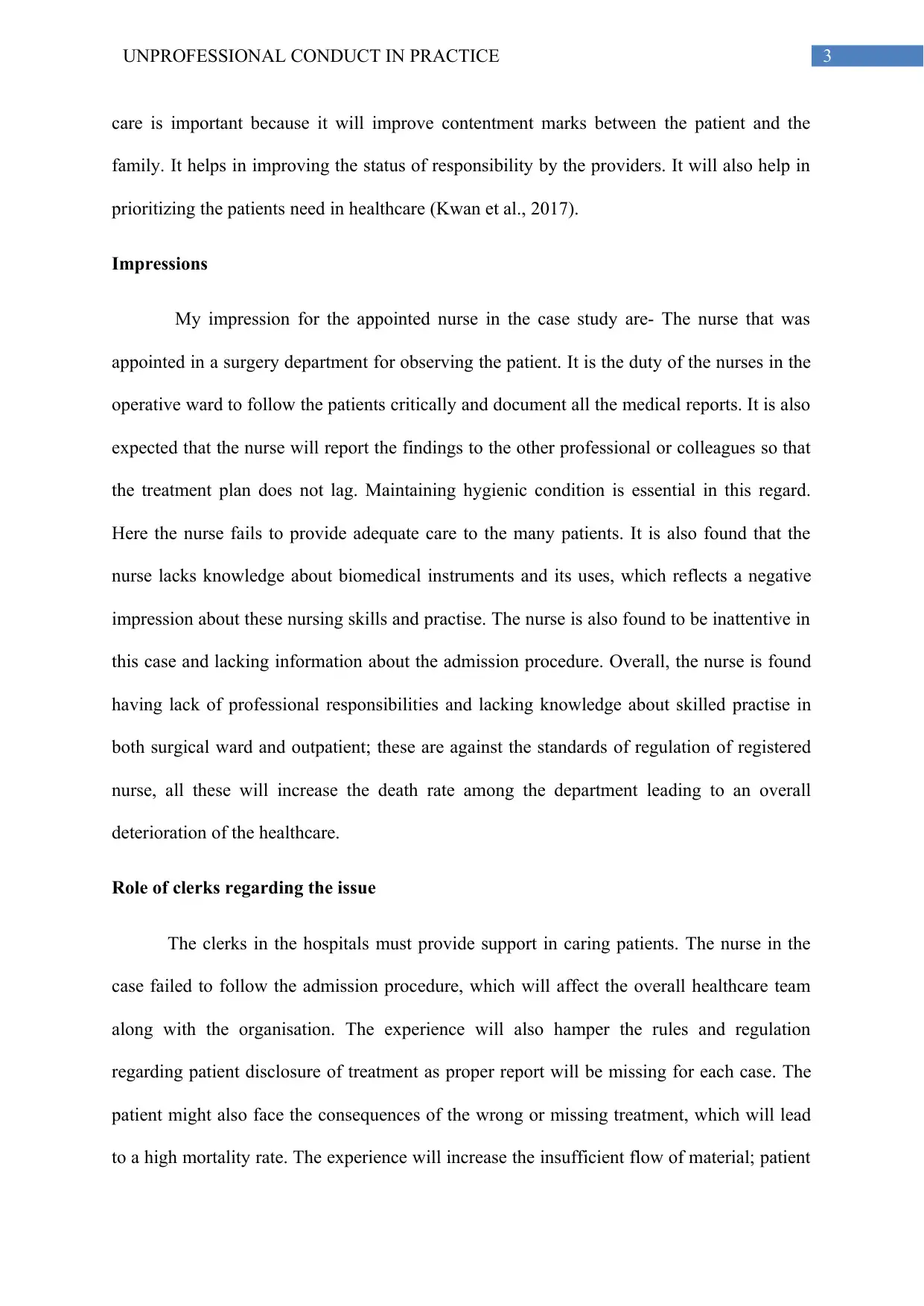
3UNPROFESSIONAL CONDUCT IN PRACTICE
care is important because it will improve contentment marks between the patient and the
family. It helps in improving the status of responsibility by the providers. It will also help in
prioritizing the patients need in healthcare (Kwan et al., 2017).
Impressions
My impression for the appointed nurse in the case study are- The nurse that was
appointed in a surgery department for observing the patient. It is the duty of the nurses in the
operative ward to follow the patients critically and document all the medical reports. It is also
expected that the nurse will report the findings to the other professional or colleagues so that
the treatment plan does not lag. Maintaining hygienic condition is essential in this regard.
Here the nurse fails to provide adequate care to the many patients. It is also found that the
nurse lacks knowledge about biomedical instruments and its uses, which reflects a negative
impression about these nursing skills and practise. The nurse is also found to be inattentive in
this case and lacking information about the admission procedure. Overall, the nurse is found
having lack of professional responsibilities and lacking knowledge about skilled practise in
both surgical ward and outpatient; these are against the standards of regulation of registered
nurse, all these will increase the death rate among the department leading to an overall
deterioration of the healthcare.
Role of clerks regarding the issue
The clerks in the hospitals must provide support in caring patients. The nurse in the
case failed to follow the admission procedure, which will affect the overall healthcare team
along with the organisation. The experience will also hamper the rules and regulation
regarding patient disclosure of treatment as proper report will be missing for each case. The
patient might also face the consequences of the wrong or missing treatment, which will lead
to a high mortality rate. The experience will increase the insufficient flow of material; patient
care is important because it will improve contentment marks between the patient and the
family. It helps in improving the status of responsibility by the providers. It will also help in
prioritizing the patients need in healthcare (Kwan et al., 2017).
Impressions
My impression for the appointed nurse in the case study are- The nurse that was
appointed in a surgery department for observing the patient. It is the duty of the nurses in the
operative ward to follow the patients critically and document all the medical reports. It is also
expected that the nurse will report the findings to the other professional or colleagues so that
the treatment plan does not lag. Maintaining hygienic condition is essential in this regard.
Here the nurse fails to provide adequate care to the many patients. It is also found that the
nurse lacks knowledge about biomedical instruments and its uses, which reflects a negative
impression about these nursing skills and practise. The nurse is also found to be inattentive in
this case and lacking information about the admission procedure. Overall, the nurse is found
having lack of professional responsibilities and lacking knowledge about skilled practise in
both surgical ward and outpatient; these are against the standards of regulation of registered
nurse, all these will increase the death rate among the department leading to an overall
deterioration of the healthcare.
Role of clerks regarding the issue
The clerks in the hospitals must provide support in caring patients. The nurse in the
case failed to follow the admission procedure, which will affect the overall healthcare team
along with the organisation. The experience will also hamper the rules and regulation
regarding patient disclosure of treatment as proper report will be missing for each case. The
patient might also face the consequences of the wrong or missing treatment, which will lead
to a high mortality rate. The experience will increase the insufficient flow of material; patient
Paraphrase This Document
Need a fresh take? Get an instant paraphrase of this document with our AI Paraphraser
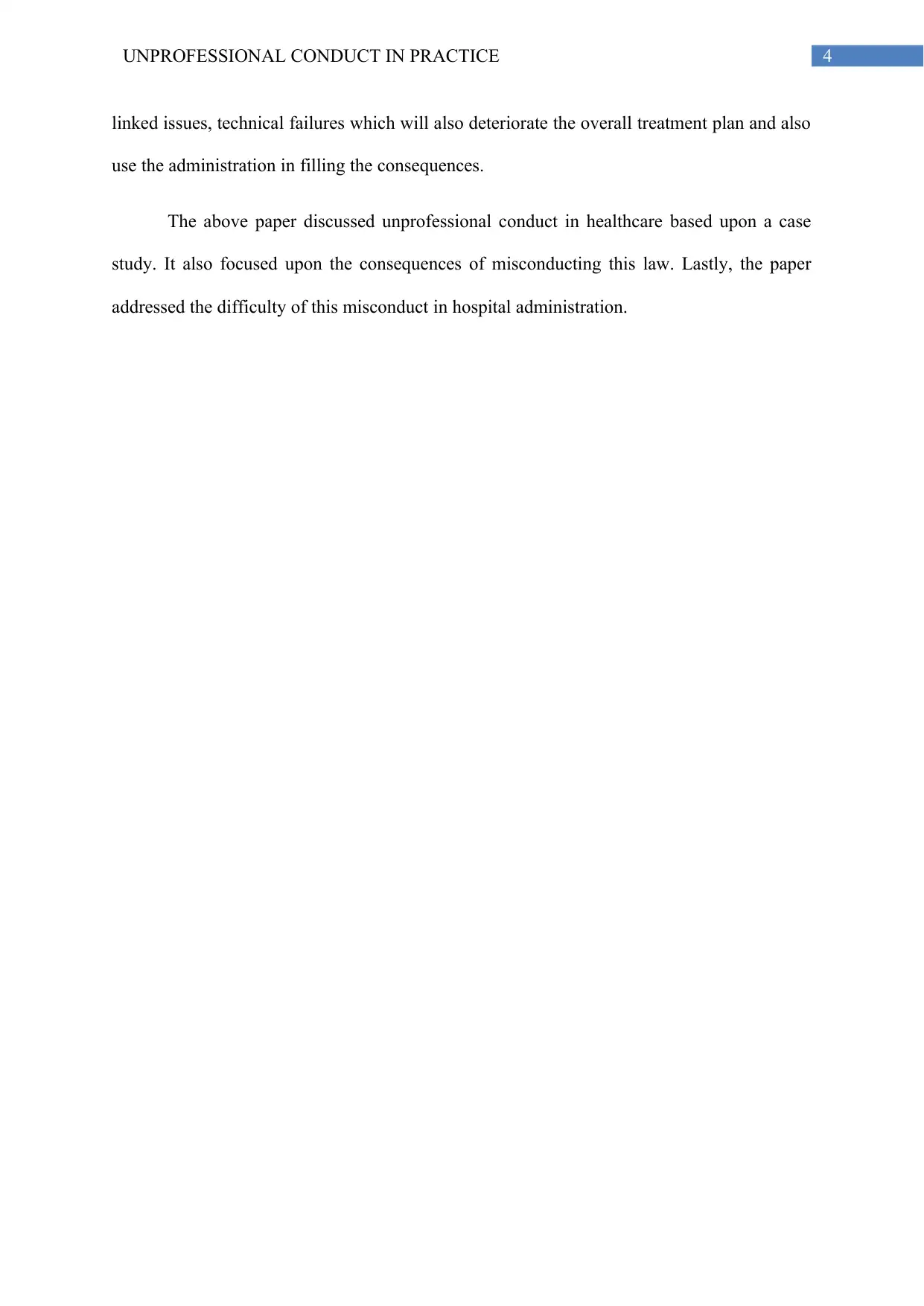
4UNPROFESSIONAL CONDUCT IN PRACTICE
linked issues, technical failures which will also deteriorate the overall treatment plan and also
use the administration in filling the consequences.
The above paper discussed unprofessional conduct in healthcare based upon a case
study. It also focused upon the consequences of misconducting this law. Lastly, the paper
addressed the difficulty of this misconduct in hospital administration.
linked issues, technical failures which will also deteriorate the overall treatment plan and also
use the administration in filling the consequences.
The above paper discussed unprofessional conduct in healthcare based upon a case
study. It also focused upon the consequences of misconducting this law. Lastly, the paper
addressed the difficulty of this misconduct in hospital administration.
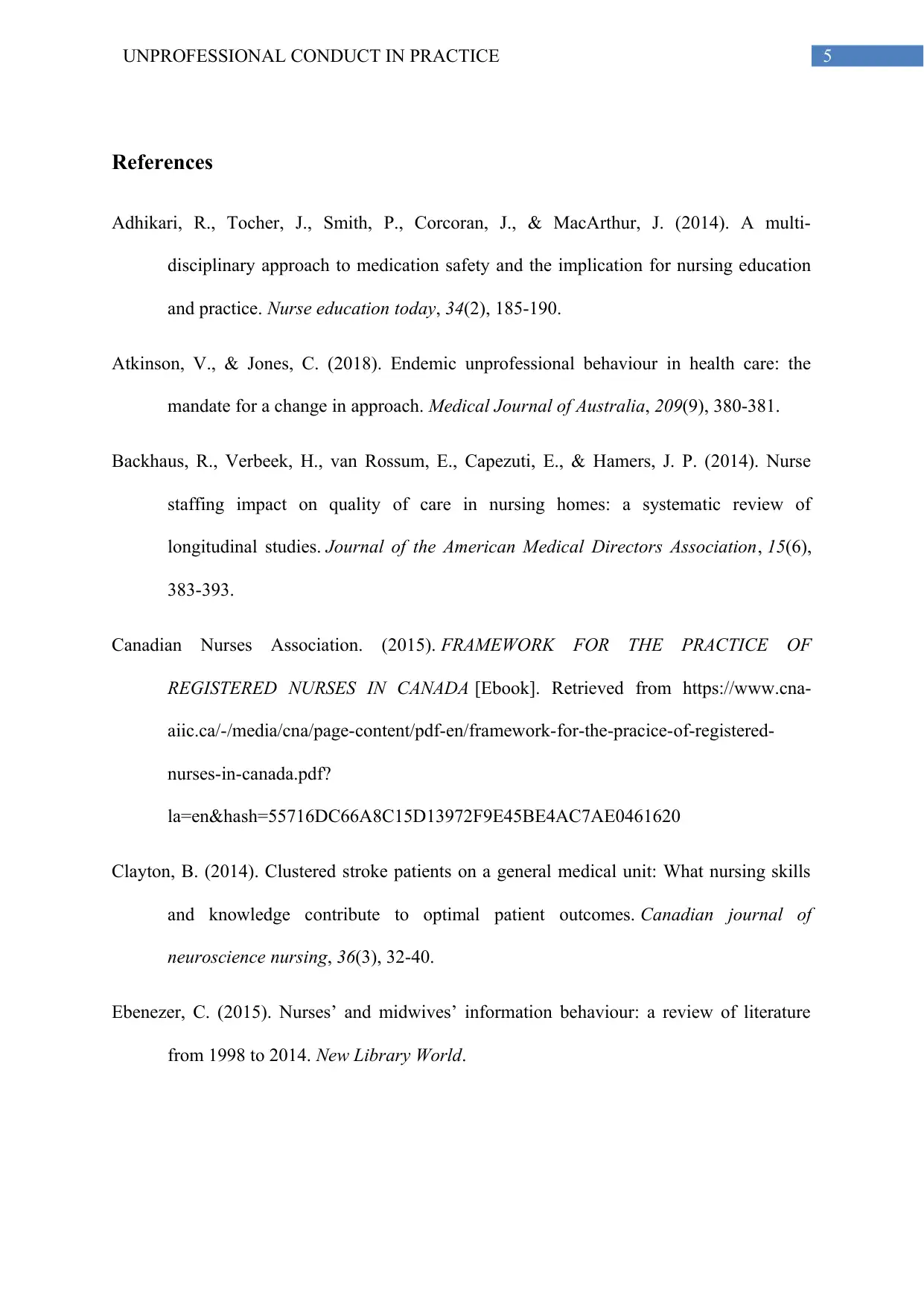
5UNPROFESSIONAL CONDUCT IN PRACTICE
References
Adhikari, R., Tocher, J., Smith, P., Corcoran, J., & MacArthur, J. (2014). A multi-
disciplinary approach to medication safety and the implication for nursing education
and practice. Nurse education today, 34(2), 185-190.
Atkinson, V., & Jones, C. (2018). Endemic unprofessional behaviour in health care: the
mandate for a change in approach. Medical Journal of Australia, 209(9), 380-381.
Backhaus, R., Verbeek, H., van Rossum, E., Capezuti, E., & Hamers, J. P. (2014). Nurse
staffing impact on quality of care in nursing homes: a systematic review of
longitudinal studies. Journal of the American Medical Directors Association, 15(6),
383-393.
Canadian Nurses Association. (2015). FRAMEWORK FOR THE PRACTICE OF
REGISTERED NURSES IN CANADA [Ebook]. Retrieved from https://www.cna-
aiic.ca/-/media/cna/page-content/pdf-en/framework-for-the-pracice-of-registered-
nurses-in-canada.pdf?
la=en&hash=55716DC66A8C15D13972F9E45BE4AC7AE0461620
Clayton, B. (2014). Clustered stroke patients on a general medical unit: What nursing skills
and knowledge contribute to optimal patient outcomes. Canadian journal of
neuroscience nursing, 36(3), 32-40.
Ebenezer, C. (2015). Nurses’ and midwives’ information behaviour: a review of literature
from 1998 to 2014. New Library World.
References
Adhikari, R., Tocher, J., Smith, P., Corcoran, J., & MacArthur, J. (2014). A multi-
disciplinary approach to medication safety and the implication for nursing education
and practice. Nurse education today, 34(2), 185-190.
Atkinson, V., & Jones, C. (2018). Endemic unprofessional behaviour in health care: the
mandate for a change in approach. Medical Journal of Australia, 209(9), 380-381.
Backhaus, R., Verbeek, H., van Rossum, E., Capezuti, E., & Hamers, J. P. (2014). Nurse
staffing impact on quality of care in nursing homes: a systematic review of
longitudinal studies. Journal of the American Medical Directors Association, 15(6),
383-393.
Canadian Nurses Association. (2015). FRAMEWORK FOR THE PRACTICE OF
REGISTERED NURSES IN CANADA [Ebook]. Retrieved from https://www.cna-
aiic.ca/-/media/cna/page-content/pdf-en/framework-for-the-pracice-of-registered-
nurses-in-canada.pdf?
la=en&hash=55716DC66A8C15D13972F9E45BE4AC7AE0461620
Clayton, B. (2014). Clustered stroke patients on a general medical unit: What nursing skills
and knowledge contribute to optimal patient outcomes. Canadian journal of
neuroscience nursing, 36(3), 32-40.
Ebenezer, C. (2015). Nurses’ and midwives’ information behaviour: a review of literature
from 1998 to 2014. New Library World.
⊘ This is a preview!⊘
Do you want full access?
Subscribe today to unlock all pages.

Trusted by 1+ million students worldwide
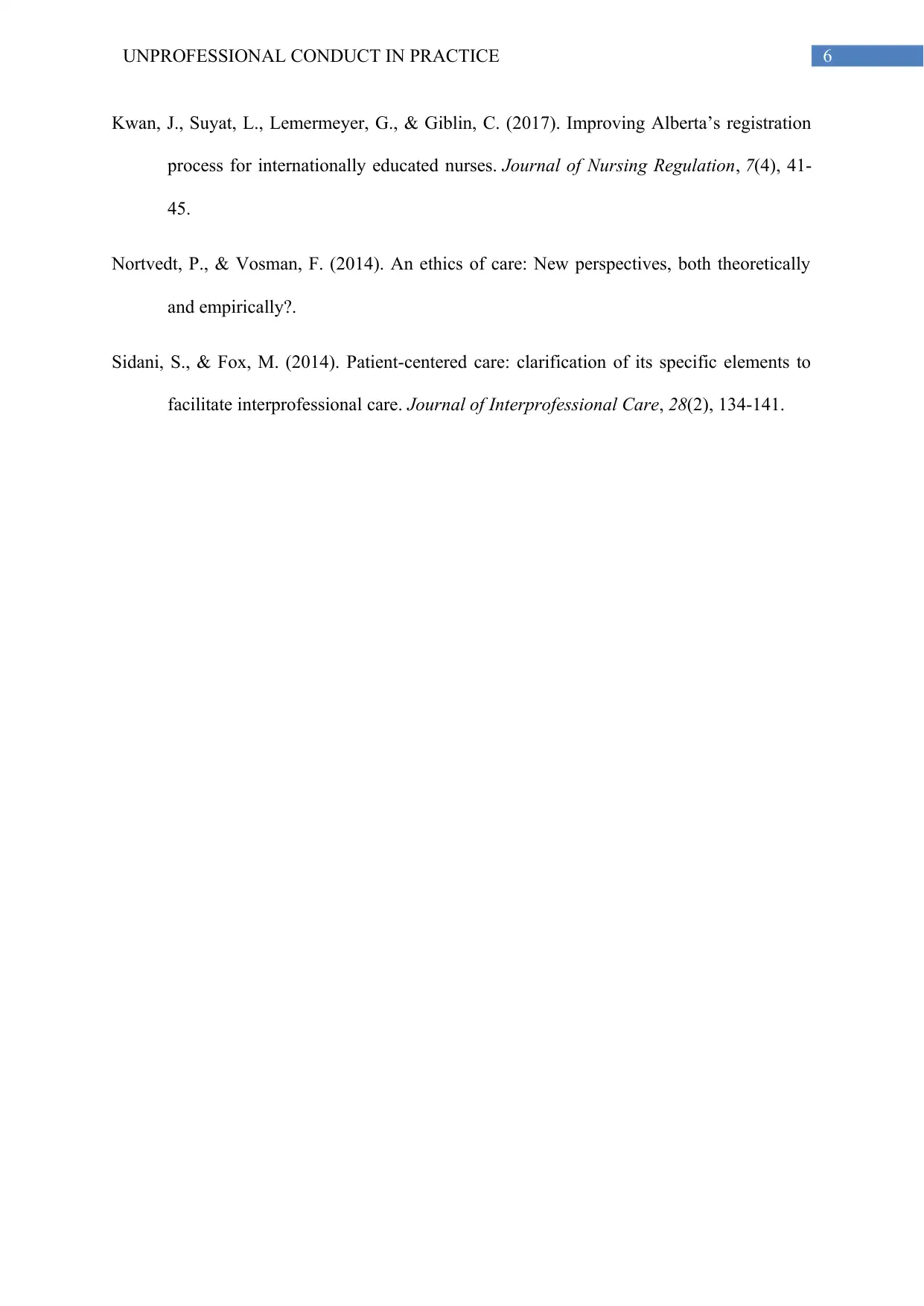
6UNPROFESSIONAL CONDUCT IN PRACTICE
Kwan, J., Suyat, L., Lemermeyer, G., & Giblin, C. (2017). Improving Alberta’s registration
process for internationally educated nurses. Journal of Nursing Regulation, 7(4), 41-
45.
Nortvedt, P., & Vosman, F. (2014). An ethics of care: New perspectives, both theoretically
and empirically?.
Sidani, S., & Fox, M. (2014). Patient-centered care: clarification of its specific elements to
facilitate interprofessional care. Journal of Interprofessional Care, 28(2), 134-141.
Kwan, J., Suyat, L., Lemermeyer, G., & Giblin, C. (2017). Improving Alberta’s registration
process for internationally educated nurses. Journal of Nursing Regulation, 7(4), 41-
45.
Nortvedt, P., & Vosman, F. (2014). An ethics of care: New perspectives, both theoretically
and empirically?.
Sidani, S., & Fox, M. (2014). Patient-centered care: clarification of its specific elements to
facilitate interprofessional care. Journal of Interprofessional Care, 28(2), 134-141.
1 out of 7
Related Documents
Your All-in-One AI-Powered Toolkit for Academic Success.
+13062052269
info@desklib.com
Available 24*7 on WhatsApp / Email
![[object Object]](/_next/static/media/star-bottom.7253800d.svg)
Unlock your academic potential
Copyright © 2020–2025 A2Z Services. All Rights Reserved. Developed and managed by ZUCOL.





